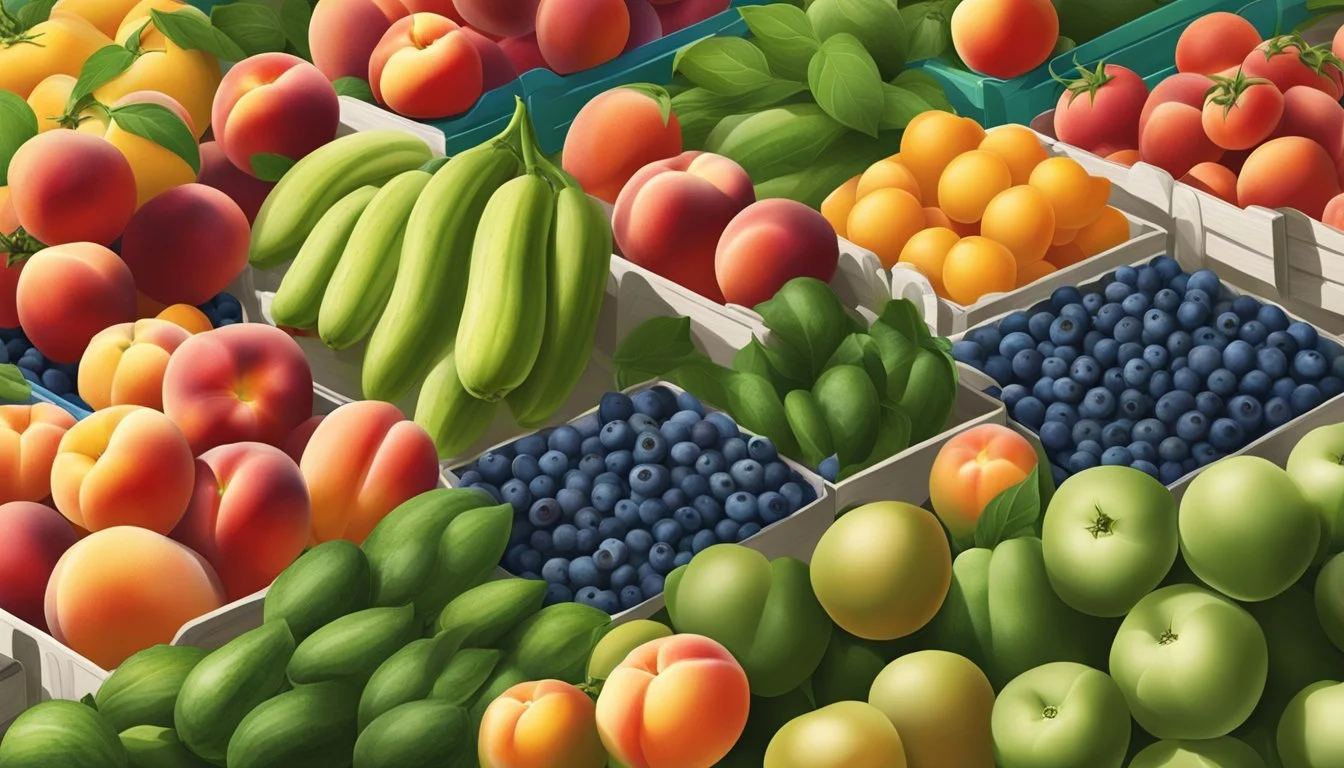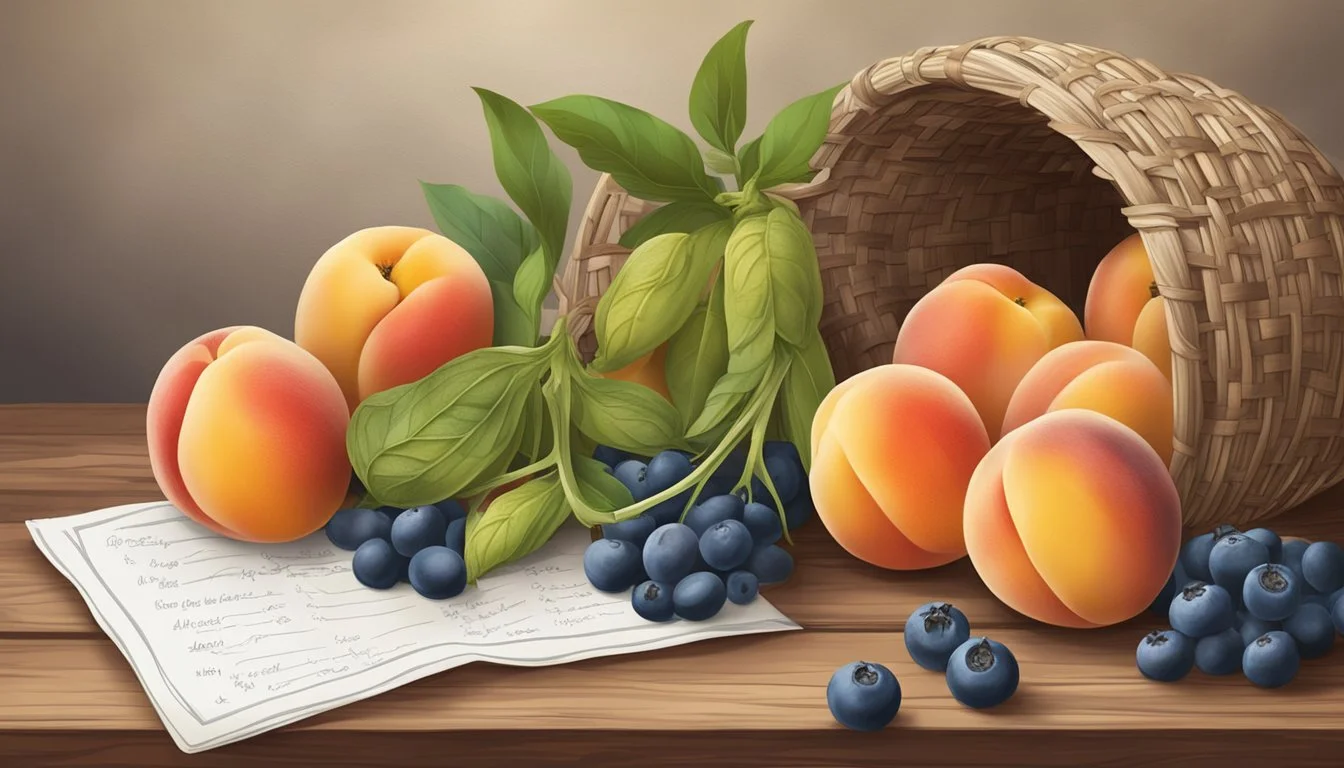Rhode Island Seasonal Fruit & Vegetables in August
Your Fresh Guide
This Article is Part of our Rhode Island Seasonal Fruit & Veg Calendar
In Rhode Island, August marks the peak of summer when an array of fruits and vegetables reach their prime ripeness. Local farmers and gardeners harvest a bounty of produce as the warm weather cultivates a perfect growing environment. The focus on fresh, locally-grown produce during this season encourages residents and visitors alike to indulge in the flavors that define summer in the Ocean State.
Throughout August, Rhode Island's markets overflow with seasonal offerings. Fruits such as peaches, melons, and various berries arrive in vibrant hues, offering not just a taste of summer but also a boost of nutrition. Vegetables are equally abundant, with tomatoes (What wine goes well with tomatoes?), cucumbers (how long do cucumbers last?), sweet corn (how long does corn last?), and a variety of greens filling farm stands. These summer months are an excellent time for chefs and home cooks to experiment with the freshest produce, creating dishes that are as flavorful as they are colorful.
Consumers are increasingly seeking local and seasonal produce for its superior taste and environmental benefits. Rhode Island delivers this in August, supporting a sustainable agriculture model that benefits local economies and promotes a healthier lifestyle. Shopping for fruits and vegetables during their natural harvesting season in Rhode Island not only ensures peak flavor and nutrition but also aligns with a conscious choice to support the local food movement.
Overview of Rhode Island's Growing Season
Rhode Island's growing season is dynamic, with a schedule tailored to take advantage of the climate. This ensures a variety of fresh produce reaches peak ripeness at different times from June through September.
Importance of the Growing Calendar
The planting and harvesting calendar is crucial for ensuring that farms operate efficiently and produce is picked at the height of freshness and nutrition. In Rhode Island, the growing season's calendaring aids local farmers in determining the best time for planting and harvesting to maximize yield and quality.
Overview of Produce from June to September
During the summer months of June and July, Rhode Island's climate supports the harvest of a range of fruit and vegetables. By August, the state is at the height of its harvesting season.
June: Berry season begins, offering strawberries and then blueberries (how long do blueberries last?).
July: The time for cherries and summer squashes, with the vegetable harvest really getting into full swing.
August: Brings an abundance of produce including:
Tomatoes
Peppers
Corn
Green beans
Cucumbers
In September, as temperatures begin to cool, the focus shifts toward early fall produce. Farmers may begin to harvest crops that prefer cooler weather, like certain types of leafy greens.
Rhode Island's growing season makes the state's farms lively with activity and provides the residents and local markets with fresh, seasonal produce throughout the summer. Harvest times can vary slightly from year to year, but this general schedule gives an overview of when one can expect various fruits and vegetables to be available.
Key Fruit and Vegetable Harvests in August
August marks the peak season for various fruits and vegetables in Rhode Island. This is when the warmth of summer contributes to the ripening and flavor of certain key produce, making it an ideal time for harvesting.
Stone Fruits Peaking in August
Peaches are a highlight in August. They reach their juicy prime during this month, offering sweetness and succulence. Local orchards often invite the public to pick these fruits straight from the trees.
Berries Thriving in Late Summer
Blueberries and raspberries continue to thrive in the late summer. These berries are found in abundance, with bushes heavily laden with ripe, plump fruit perfect for picking. They are not only enjoyed fresh but also widely used in preserves and baking.
Summer Vegetables at Their Prime
Many summer vegetables are at their best in August.
Tomatoes are vibrant and flavorful, available in various sizes and colors.
Eggplant features prominently in local markets, with its shiny purple skin indicating freshness.
Corn, a staple in summer diets, is sweet and tender.
Beans, peppers, and squash add diversity to the summer harvest with their array of colors and flavors.
Cucumbers are crisp and refreshing, often harvested when they are medium-sized for the best texture and taste.
Local farms and gardens are teeming with these vegetables, and many are harvested daily to ensure the freshest quality for consumers.
Eating Locally and Seasonally
In August, Rhode Island's agricultural bounty is at its peak, offering a rich variety of in-season produce. Residents have the opportunity to enjoy flavors at their freshest, directly from local farms to their tables.
Benefits of Consuming In-Season Produce
Eating in-season significantly enhances the nutritional value and taste of fruits and vegetables. They are typically harvested at their peak and sold during their optimal flavor window. Local Rhode Island produce in August includes a variety of fruits and vegetables such as corn, tomatoes, peppers, and peaches.
Consuming in-season is not only beneficial for health but also supports the local economy. It bolsters local farmers and reduces the carbon footprint associated with long-distance transportation.
How to Find Fresh Local Produce in Rhode Island
One can locate fresh, in-season produce in Rhode Island through numerous channels:
Farmers Markets: For example, the Farm Fresh RI's Farmers Market, operational from June through October, is a hub for local produce.
Farms: Visit local farms where one can purchase directly from the source. Events often hosted on farms across the state highlight the season's offerings.
Food Guides: Seasonal food guides specify what produce is available through various parts of the year. Such guides are invaluable in planning shopping trips to ensure the freshest local ingredients.
To make the most of what Rhode Island has to offer in August, shoppers should prioritize these avenues to enrich their diet with fresh, local, and in-season produce.
Seasonal Recipes and Cooking Tips
In August, Rhode Island's local produce offers an abundance of fresh flavors perfect for seasonal recipes and preserving techniques. Chef's can revel in the peak of summer's gifts with tomatoes, eggplants, and berries.
Cooking with August Harvests
Tomatoes: The versatility of fresh August tomatoes is exceptional. They can be used in a bright, acidic gazpacho or sliced for a classic Caprese salad (What wine goes well with caprese salad?) with a drizzle of olive oil and fresh basil. For cooking, one could make a rich, rustic tomato sauce to complement any pasta dish or as a base for stews and soups.
Gazpacho Recipe: Blend fresh tomatoes, cucumbers, red onions, green bell peppers, and garlic with olive oil, vinegar, and salt for a refreshing cold soup.
Caprese Salad: Alternate slices of tomato and fresh mozzarella, add basil leaves, season with salt, and drizzle with extra-virgin olive oil.
Eggplant: This versatile vegetable absorbs flavors beautifully. It can be roasted and incorporated into a baba ganoush or thinly sliced for a layered eggplant parmesan (What wine goes well with eggplant parmesan?).
Baba Ganoush Recipe: Roast eggplant until tender, scoop out the flesh and blend with tahini, garlic, lemon juice, and spices for a delicious dip.
Eggplant Parmesan: Layer fried or baked eggplant slices with marinara sauce and mozzarella cheese, then bake until bubbly.
Berries: Fresh August berries are perfect for sweet treats. Blueberries, raspberries, and blackberries can be made into a simple berry compote to top pancakes or used in a berry crumble for a quick, delicious dessert.
Berry Compote Recipe: Simmer mixed berries with a bit of sugar and a squeeze of lemon juice until the berries break down into a sauce.
Berry Crumble: Toss berries with sugar and lemon juice, top with a mix of flour, oats, sugar, and butter, then bake until golden.
Preserving Summer's Bounty
Preserving summer produce allows one to enjoy the flavors year-round. Tomatoes can be canned as sauces or salsas, while berries can be made into jams or frozen for later use.
Tomato Preservation:
Canning: Cook down tomatoes to make a sauce, salsa, or whole canned tomatoes. Always follow safe canning practices to ensure longevity.
Freezing: Tomatoes can also be frozen whole, sliced, or as a sauce. Blanch and peel for easier use after freezing.
Berry Preservation:
Jams and Jellies: Cook down berries with sugar and pectin to create jams and jellies that capture the essence of summer.
Freezing: Wash, dry, and spread berries in a single layer on a baking sheet to freeze, then transfer to airtight containers for long-term storage.
Agricultural Events in August in Rhode Island
August in Rhode Island showcases the state's rich agricultural tapestry with events that celebrate local produce at the peak of its seasonality. From lively farmers' markets to pick-your-own farm adventures, the local communities come together to enjoy the fruits of the season.
Farmers' Markets and Festivals
Rhode Island's farmers' markets bloom in August with a colorful array of fresh fruits and vegetables. These markets offer an opportunity to support local farmers and artisans while enjoying the vibrant community atmosphere. The Providence Farmers Market, known for its diverse selection of local goods, operates in full swing during this month. Visitors can find a bounty of fresh produce such as tomatoes, corn, peaches, and berries, along with handcrafted items and live entertainment.
Alongside regular markets, August often features food festivals where the state's agriculture is in the spotlight. Examples include The Washington County Fair, which celebrates local agriculture with events, exhibits, and food stands offering farm-fresh fare like zucchini, eggplant, and Rhode Island’s famous sweet corn.
Pick-Your-Own Fruit and Vegetable Farms
August is also prime time for pick-your-own fruit and vegetable farms in Rhode Island. These farms invite visitors to experience the joy of harvesting their own food directly from the source. During this month, a variety of fruits reach their peak, including blueberries, raspberries, and blackberries. Families can spend a day in the sun roaming the farms, selecting the freshest produce to take home.
Seasonal activities often extend beyond picking; many farms also host events such as hayrides, corn mazes, and tours that educate visitors about local agriculture and sustainable farming practices. It’s the perfect time to enjoy the outdoors and learn more about where food comes from while engaging in a fun and fulfilling activity.






